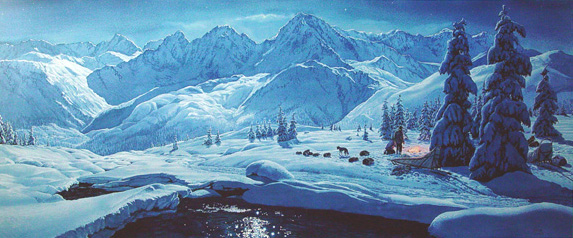

About "In the Gulf":
Kayak Island, is believed to be the first place in Alaska where Captain Vitus Bering, sailing on orders from Peter the Great, Czar of Russia, would send ashore a party of men. With many hours invested in reading the journals; library and internet research, tracking down plans of the ship and after nearly a years work, I believe I have been able to capture a fairly accurate recreation of the ship on this epic voyage of discovery. I hope you will enjoy it.
In September 1740 after Bering's ships the St. Peter and St. Paul were completed, in Okhotsk on the Siberian Coast, the expedition sailed to the Kamchatka Peninsula with Bering and his two expeditionary vessels sailing around the peninsula's south tip and up to Avacha Bay on the Pacific coast. Georg Wilhelm Steller a German botanist, zoologist, physician went ashore on the east coast of Kamchatka to spend the winter in Bolsherechye, where he helped to organize a local school and began exploring Kamchatka. When Bering summoned him to join the voyage in search of America and the strait between the two continents, serving in the role of scientist and physician, Steller crossed the peninsula by dog sled. From Avacha Bay, Bering led the expedition towards America in 1741. On 4 June 1741 he sailed from Kamchatka aboard the St. Peter with Lieutenant Aleksey Chirikov commanding the St. Paul. First the two captains headed southeast in search of the mythical da Gama Land, which was a prominent feature on an earlier map. Unfortunately, by the time Bering had altered his direction to the northeast, they had sailed hundreds of miles south while missing the entire Aleutian chain. On June 20, 1741 Bering's St. Peter was separated from its companion ship the St. Paul in a storm. After searching fruitlessly for the St. Paul, Bering continued to sail east, expecting to find land soon. Steller, reading sea currents and flotsam and wildlife, insisted they should sail northeast. After considerable time lost they turned northeast and made landfall in Alaska at Kayak Island on Monday 20 July 1741. Bering wanted to stay only long enough to take on fresh water. A frustrated Steller argued with Captain Bering asking him for more time for land exploration, but was granted only 10 hours. During this time, as the first non-native to have set foot upon Alaskan soil, Steller became the first European naturalist to describe a number of North American plants and animals, including a jay later named Steller's jay. As Steller later complained, it took him ten years to get to this new continent and he was only given ten hours to study it, as Bering was hurrying north while mapping the coastline. Having lost his safety net of the St. Paul Bering was anxious to get the ship back to Russia. Bering was able to reconnoiter only the southwestern coast of Alaska Bay, the Alaskan Peninsula, and the Aleutian Islands. Catching sight of a volcanic peak, he named it Mount St. Elias, the name it still bears today. Bering's epic voyage was filled with hardship and too many adventures to list here. For a great read and "The rest of the story." I recommend the book "Where the Sea Breaks it's Back" by Corey Ford. Best Wishes, Charles